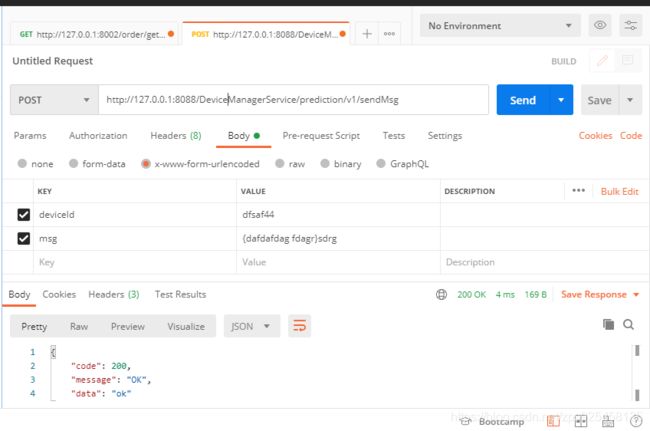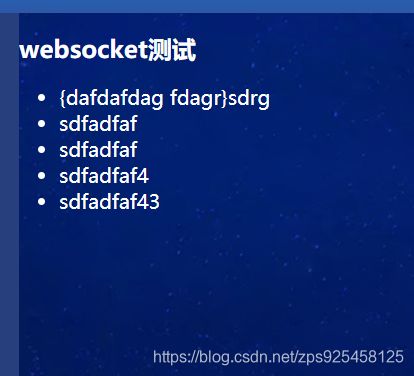springboot2.x集成websocket,Vue2.x使用websocket,完整前后分离通信demo
前言
什么是websocket
websocket协议
WebSocket protocol 是HTML5一种新的协议。它实现了浏览器与服务器全双工通信(full-duple)。一开始的握手需要借助HTTP请求完成。
通俗的来讲,websocket是客户端与服务端建立连接之后,客户端可以监听到服务端发来的消息,服务端也可以监听到客户端发来的消息。
java后端构建websocket服务
1.依赖引入
<dependency>
<groupId>org.springframework.bootgroupId>
<artifactId>spring-boot-starter-websocketartifactId>
dependency>
2.启动类开启websocket支持
@SpringBootApplication
@EnableWebSocket
public class WebSocketApplication extends SpringBootServletInitializer {
// code...
}
3.websocket配置类
import org.springframework.context.annotation.Bean;
import org.springframework.context.annotation.Configuration;
import org.springframework.web.socket.server.standard.ServerEndpointExporter;
@Configuration
public class WebSocketConfig {
/**
* 初始化Bean,它会自动注册使用了 @ServerEndpoint 注解声明的 WebSocket endpoint
* @return
*/
@Bean
public ServerEndpointExporter serverEndpointExporter() {
return new ServerEndpointExporter();
}
}
4.websocket服务端
注意此处的Session是websocket包下的session
import com.deepocean.device.websocket.utils.WsSessionUtils;
import org.springframework.stereotype.Controller;
import javax.websocket.*;
import javax.websocket.server.PathParam;
import javax.websocket.server.ServerEndpoint;
@Controller
@ServerEndpoint("/webSocket/{deviceId}")
public class WebSocketController {
/**
* 连接建立成功调用的方法
*
*/
@OnOpen
public void onOpen(@PathParam("deviceId")String deviceId, Session session) {
WsSessionUtils.putSession(deviceId, session);
System.out.println("连接加入");
}
/**
* 关闭连接的方法
*/
@OnClose
public void onClose(Session session) {
WsSessionUtils.sessionMap.remove(session);
System.out.println("连接关闭");
}
/**
* 接受到消息的方法
*/
@OnMessage
public void onMessage(String message, Session session) {}
@OnError
public void onError(Session session, Throwable error) {
}
}
5.websocket的session操作、存储工具类
import org.springframework.util.StringUtils;
import javax.websocket.Session;
import java.util.Map;
import java.util.concurrent.ConcurrentHashMap;
public class WsSessionUtils {
public static Map<String, Session> sessionMap = new ConcurrentHashMap<>();
public static Session getSession(String deviceId) {
if (StringUtils.isEmpty(deviceId)) {
return null;
}
return sessionMap.get(deviceId);
}
public static boolean putSession(String deviceId, Session session) {
if (StringUtils.isEmpty(deviceId) || null == session) {
return false;
}
sessionMap.put(deviceId, session);
return true;
}
public static boolean removeSession(String deviceId) {
if (StringUtils.isEmpty(deviceId)) {
return false;
}
sessionMap.remove(deviceId);
return true;
}
}
VUE前端构建Websocket连接组件
注意:如何后端tomcat配置了 servelet.context-path,那么前端发起连接的时候也应该带上,如下面代码的url中的 /WebSocketService就是context-path
<template>
<div>
<h2 style="color: white">websocket测试</h2>
<ul style="color: white; font-size: 20px">
<li v-for="(value, index) in list" :key="index">{{value}}</li>
</ul>
</div>
</template>
<script>
export default {
name: "DeviceWebSocket",
data() {
return {
websocket: "",
list: []
}
},
methods: {
initWebSocket() {
let url = "ws://127.0.0.1:8088/WebSocketService/webSocket/dfsaf44";
this.websocket = new WebSocket(url);
// 监听socket连接
this.websocket.onopen = this.open
// 监听socket错误信息
this.websocket.onerror = this.error
// 监听socket消息
this.websocket.onmessage = this.getMessage
},
open() {
console.log("socket连接成功")
},
getMessage(msg) {
this.list.push(msg.data)
console.log(msg.data)
},
error() {
console.log("连接错误")
},
sendMsg() {
this.websocket.send("123")
console.log("发送消息")
},
},
mounted() {
this.initWebSocket();
},
destroyed () {
// 关闭连接
this.socket.close();
}
}
</script>
<style>
</style>
效果

postman发送数据,后端接收数据之后,通过deviceId获取对应websocket连接的session;并调用send方法。

前端会实时的接受到后端推送过来的消息,并展示